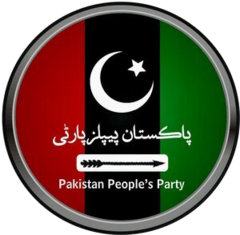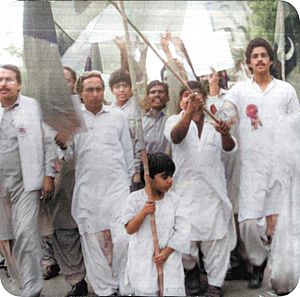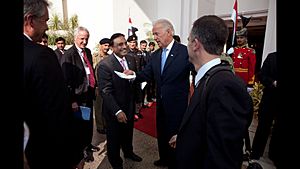Pakistan People's Party facts for kids
Quick facts for kids
Pakistan People's Party
پاکستان پیپلز پارٹی
|
|
|---|---|
 |
|
| Abbreviation | PPP |
| President | Asif Ali Zardari |
| Chairman | Bilawal Bhutto Zardari |
| Secretary-General | Nayyar Hussain Bukhari |
| Historical leaders | |
| Leader in Senate | Yousaf Raza Gillani |
| Leader in National Assembly | Bilawal Bhutto Zardari |
| Founder | Zulfiqar Ali Bhutto |
| Founded | 30 November 1967 Lahore, West Pakistan |
| Headquarters | People's Secretariat, Parliament Lodges, Red Zone, Islamabad |
| Student wing | Peoples Students Federation |
| Human Rights Cell | Human Rights Cell |
| Ideology | Social democracy Third Way Secularism Progressivism Historical:
Islamic socialism
Islamic liberalism Left-wing populism |
| Political position | Centre-left |
| National affiliation | Pakistan Peoples Party Parliamentarians Pakistan Democratic Movement |
| International affiliation | Socialist International |
| Colors | Red Black Green |
| Slogan | روٹی، کپڑا اور مکان Roti, Kapra aur Makaan (lit. Bread, Clothes, and House) |
| Senate |
20 / 100
|
| National Assembly |
58 / 342
|
| Punjab Assembly | Assembly dissolved |
| Sindh Assembly |
99 / 168
|
| KP Assembly | Assembly dissolved |
| Gilgit-Baltistan Assembly |
4 / 33
|
| Azad Kashmir Assembly |
13 / 53
|
| Election symbol | |
| Party flag | |
 |
|
| Website | |
| Official website: http://www.ppp.org.pk/ | |
The Pakistan People's Party (PPP) is a major political party in Pakistan. It is known for its social-democratic ideas, which means it believes in a fair society where everyone has equal opportunities. The party is currently one of the largest in Pakistan's National Assembly and the Senate of Pakistan.
The PPP was started in 1967 in Lahore. It was formed by Zulfiqar Ali Bhutto and other politicians who wanted to oppose the military rule at that time. The party is connected to the Socialist International, a group of similar parties worldwide. The PPP aims to make Pakistan a social-democratic country. It supports secular (non-religious) and egalitarian (equal for all) values. It also works for social justice and a strong military. The PPP is one of the three biggest political parties in Pakistan.
Since 1967, the PPP has been a powerful force in Pakistan's politics. The Bhutto family has largely led the party. Its main support base is in the southern province of Sindh. The PPP has won elections and formed the government five times. These were in 1970, 1977, 1988, 1993, and 2008. It has also been the main opposition party four times. Four prime ministers of Pakistan have come from the PPP.
The party was very strong in the 1970s. It faced challenges during the military rule of President Muhammad Zia-ul-Haq. After democracy returned in 1988, the PPP became one of the two main parties. It was also the main opposition party against the military government from 1999 to 2008. In the 2013 election, the PPP lost a lot of support in Punjab Province. However, it kept its government in Sindh. In the 2018 election, the party did not form the government or become the largest opposition party for the first time.
Party History
How the PPP Started
The Pakistan People's Party (PPP) officially began at a meeting in Lahore on November 30 and December 1, 1967. At this meeting, Zulfikar Ali Bhutto, who was a former Foreign Minister, was chosen as the party's first chairman. The party's main goals were to create a fair democracy and use socialist ideas for economic and social justice. They also wanted to challenge the rule of President Muhammad Ayub Khan.
Early Socialist Ideas
In the 1970s, many people felt that Ayub Khan's policies helped rich business owners but not ordinary people. This led to more inequality and poverty. After the Indo-Pakistani War of 1965, Pakistan's economy struggled. The Tashkent Declaration, a peace agreement after the war, disappointed many Pakistanis. This caused a disagreement between Ayub Khan and his Foreign Minister, Zulfikar Ali Bhutto. Bhutto resigned and later formed the People's Party. He said Ayub Khan had "lost the war on the negotiating table."
Bhutto's strong stand against Ayub's government made him popular with left-wing groups. On November 30, 1967, the Pakistan People's Party was officially formed in Lahore. Its main idea was to create a more equal society. The party's slogan was: 'Islam is our Religion; Democracy is our Politics; Socialism is our Economy; Power Lies with the People'. This manifesto was published on December 9, 1967. It stated that only socialism could create equal opportunities and remove class differences.
The People's Party had different groups within it: Marxists, Islamic socialists, and wealthy landowners. In 1968, protests broke out across the country due to unemployment and economic problems. Bhutto's party quickly gained support, especially in Punjab. Their slogan 'Land to the Landless' was very popular among farmers and workers. The party promised to end the feudal system and give land to those who didn't own any. Students and teachers, who felt controlled by Ayub Khan's strict government, also joined. Many minorities were also attracted to the party's ideas. These protests eventually led to Ayub Khan's resignation in 1969. General Yahya Khan then took over and promised elections.
1970 Election and the War
General Agha Muhammad Yahya Khan took power in March 1969 and promised elections. The People's Party decided to take part in the upcoming general election. On January 4, 1970, Z.A. Bhutto started his election campaign. The PPP became the leading left-wing party in West Pakistan. In the 1970 election, the People's Party won most seats in West Pakistan. However, in East Pakistan, the Awami League won almost all the seats.
The Awami League had the right to form the government. But Bhutto argued that they shouldn't form a government for all of Pakistan since they didn't win any seats in West Pakistan. Bhutto suggested having two prime ministers, one for West and one for East Pakistan. This idea was rejected by Sheikh Mujibur Rahman, the Awami League leader. Meetings between the leaders failed to solve the problem. This led to military action in East Pakistan, which resulted in the war and the creation of Bangladesh.
After the War
After Pakistan's defeat in the 1971 war, General Yahya Khan resigned. On December 20, Zulfikar Ali Bhutto became the new President and the first civilian Chief Martial Law Administrator of what remained of Pakistan. The country was in a very difficult situation. Bhutto promised to rebuild Pakistan.
Bhutto's Time as Prime Minister
On January 2, 1972, Bhutto announced that the government would take over major industries like steel, engineering, and cement. He also introduced new rules to help trade unions. Although he came from a wealthy landowning family, Bhutto limited land ownership and gave land to farmers who had none. He also fired many government workers accused of corruption.
Bhutto successfully brought back 93,000 Pakistani prisoners of war from India. He also started Pakistan's nuclear program in January 1972. In 1973, a new constitution was approved, moving Pakistan towards a parliamentary democracy. Bhutto became Prime Minister of Pakistan on August 14, 1973. He worked to expand schools, create basic health facilities, and improve housing. However, global economic problems and rising inflation made things difficult.
In foreign policy, the People's Party built strong ties with China. Pakistan also hosted a major meeting of Islamic leaders in Lahore in 1974. Inside the party, some issues arose. Bhutto made a constitutional change in 1974, declaring the Ahmadiyya community as non-Muslims, due to pressure from religious groups. In 1973, he ordered a military operation in the Baluchistan province.
In the 1977 general election, the PPP won a large majority. But the opposition protested, claiming the elections were unfair. They called Bhutto "un-Islamic." Bhutto offered new elections, but tensions grew. Military rule was imposed by General Muhammad Zia-ul-Haq. Sadly, Zulfikar Ali Bhutto's time as leader ended in 1979.
In 1982, Bhutto's daughter, Benazir Bhutto, became the party's co-chairperson with her mother, Nusrat Bhutto. The People's Party led the Movement for the Restoration of Democracy. This was a large peaceful movement against Zia-ul-Haq's military rule.
After eleven years, the People's Party returned to power in the 1988 election. Benazir Bhutto became the first female head of government in a Muslim country. In 1990, her government was dismissed. The PPP lost the 1990 election and was in opposition for the first time. Later, the Supreme Court found that this election had been rigged.
The People's Party won again in the 1993 election. However, the party later faced internal divisions. Benazir Bhutto's government was dismissed in 1996. Since then, and after Benazir Bhutto's assassination in 2007, the party has faced challenges and internal disagreements.
Recent Times
After Benazir Bhutto was assassinated on December 27, 2007, the 2008 elections were delayed. The PPP won a big victory in the 2008 parliamentary elections, gaining 121 seats. In 2008, Asif Ali Zardari, the party's co-chairman, announced an end to dictatorships. He asked Nawaz Sharif's party to form a coalition government.
On March 9, 2008, the PPP and Pakistan Muslim League (N) signed an agreement to form a coalition. They agreed to bring back judges who had been removed from their positions. On March 28, Yousaf Raza Gillani became the Prime Minister. The PPP formed coalition governments in several provinces.
On September 5, 2008, Asif Ali Zardari was elected President of Pakistan. In April 2010, President Zardari gave up many of his powers to Prime Minister Gillani and the parliament. This was done through the 18th Amendment to the Constitution of Pakistan, helping Pakistan move further towards parliamentary democracy. The PPP remains strong in Sindh and South Punjab. In 2012, Raja Pervez Ashraf became the new Prime Minister.
In April 2022, the PPP joined a coalition government with the PML-N and other parties. Shehbaz Sharif became Prime Minister.
Party Leadership
The first leader of the Pakistan People's Party was Zulfikar Ali Bhutto. After his death, his wife, Nusrat Bhutto, became the party's chairperson. In 1982, their daughter, Benazir Bhutto, became the acting head of the party. She was later officially elected chairperson for life. She remained in this role until her assassination in 2007. After her death, her son, Bilawal Bhutto Zardari, and his father, Asif Ali Zardari, were appointed party co-chairmen on December 30, 2007.
Presidents from the PPP
| No. | Presidents | Year | Duration | Presidential elections |
|---|---|---|---|---|
| 1 | Zulfikar Ali Bhutto | 1971–1973 | 1 year, 7 months, 25 days | 20 December 1971 |
| 2 | Fazal Ilahi Chaudhry | 1973–1978 | 5 years, 1 month, 3 days | 14 August 1973 |
| 3 | Farooq Leghari | 1993–1997 | 4 years, 1 month, 19 days | 14 November 1993 |
| 4 | Asif Ali Zardari | 2008–2013 | 5 years | 6 September 2008 |
Prime Ministers from the PPP
| No. | Prime ministers | Year | Duration | Elections |
|---|---|---|---|---|
| 1 | Zulfikar Ali Bhutto | 1973–1977 | 3 years, 10 months, 21 days | 1973 |
| 2 | Benazir Bhutto | 1988–1990; 1993–1996 | 4 years, 8 months, 21 days | 1988, 1993 |
| 3 | Yousaf Raza Gillani | 2008–2012 | 4 years, 2 months, 25 days | 2008 |
| 4 | Raja Pervaiz Ashraf | 2012–2013 | 9 months, 2 days, |
Party Structure and Ideas
The Central Executive Committee (CEC) is the highest leadership body of the PPP. It guides the party's activities, campaigns, and public policies. The CEC is currently led by Asif Ali Zardari.
The PPP also has a youth organization called PPP-Young Organization. It helps involve young people in politics. The party's student wing, the Peoples Students Federation, trains and engages new generations of party members.
Each province and territory in Pakistan has a local committee for the PPP. These committees help with campaigns and local events. All major decisions and policies need approval from the CEC's co-chairman and vice-chairmen.
What the PPP Believes In
When it started in 1967, the PPP was formed by communists and socialists. The party's ideas have been very successful in Pakistani society. The PPP supports democratic socialism and social democracy. This means it believes in a mix of democracy and socialist principles. Historically, the PPP supported farmers, industrial workers, and the middle class.
The PPP has moved away from extreme left-wing ideas. It has also adopted some economic policies that support business and privatization. Despite its socialist roots, the PPP never allied with the Soviet Union. The Communist Party of Pakistan remained a rival. Recently, the PPP has focused on centrist economic and socially progressive ideas.
The core principles of the PPP are: "Islam [as] our Faith. Democracy is our Politics. Socialism is our Economy. All Power to the People".
Foreign Policy Views
The PPP's foreign policy focuses on strong relationships with China, Russia, Iran, and Turkey. Under Zulfikar Ali Bhutto, Pakistan built closer ties with these countries. Later, under Benazir Bhutto, the foreign policy shifted to include more centre-right ideas. This was to get funding from the United States and the World Bank.
Under former Prime Minister Yousaf Raza Gillani, the PPP improved its relationship with Russia. This happened as the party's relationship with the United States became cooler around 2010. In the 1970s, the PPP faced a "secret" cold war with the United States.
Science and Education
The Pakistan Peoples Party, especially under Zulfikar Ali Bhutto, is credited with starting Pakistan's atomic bomb project in 1972. A special day, Youm-e-Takbir, is celebrated to remember Bhutto's role in this program.
In the 1990s, during Benazir Bhutto's time, the PPP opened computer literacy centers. They also made Pakistan the first Muslim country to launch a satellite, Badr-I, in 1990. The party also supported the development of missile programs like Ghauri and Shaheen. They established the Pakistan Science Foundation in 1973 and the Pakistan Academy of Letters in 1976. In 1996, Benazir Bhutto established SZABIST in Karachi, a leading science and technology institution.
See also
 In Spanish: Partido del Pueblo Pakistaní para niños
In Spanish: Partido del Pueblo Pakistaní para niños



